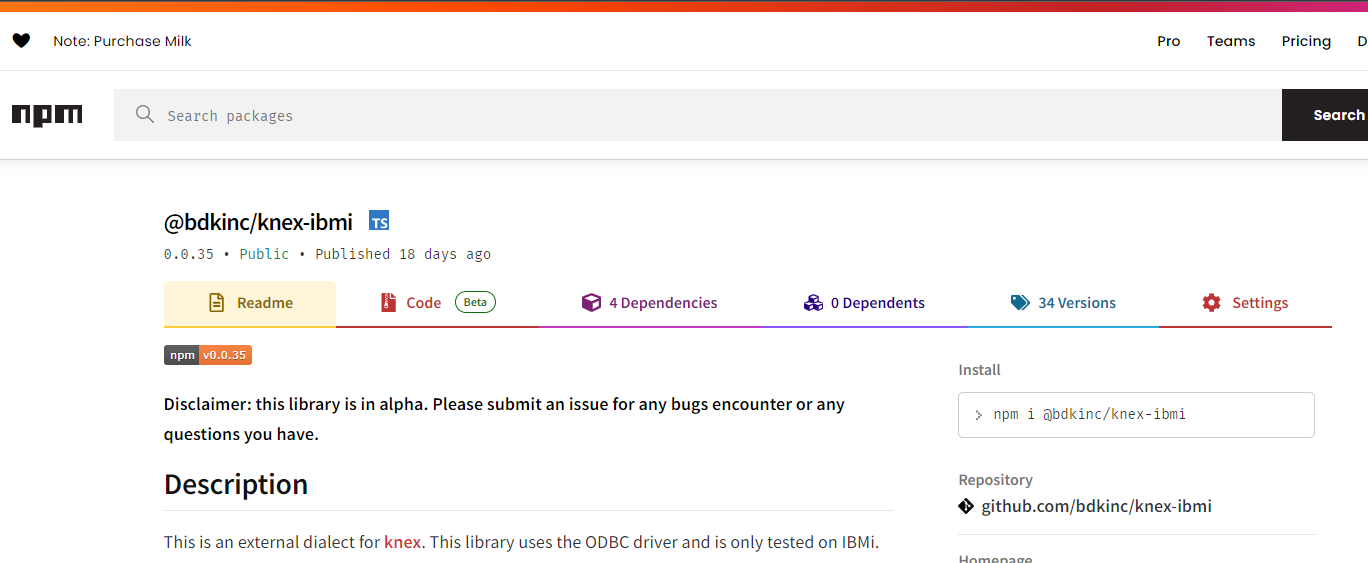IBM i (DB2) Dialect for Knex

When building Node.js applications on IBM i I traditionally reached straight for the low‑level node-odbc driver. That works, but for most projects I prefer expressing data access with a query builder (or ORM) that maps more closely to business intent. Knex is a popular, lightweight query builder and is used under the hood by other frameworks (for example Feathers).
This project implements a first‑class Knex dialect for IBM i DB2 over ODBC. It started as a fork of the long unmaintained knex-db2 but was ultimately a ground‑up rewrite in TypeScript with modern packaging (ESM + CJS builds, type defs) and IBM i specific behavior.
The current version (see NPM badge) is significantly beyond the original scope: it includes a custom migration runner tailored for IBM i, multi‑row insert strategies, returning emulation for UPDATE/DELETE, streaming with adaptive fetch sizing, improved error handling, and pragmatic identity retrieval.
Below is an updated overview of what the dialect offers today.
Quick Start
import { knex } from 'knex'
import { DB2Dialect, DB2Config } from '@bdkinc/knex-ibmi'
const config: DB2Config = {
client: DB2Dialect,
connection: {
database: '*LOCAL',
host: '127.0.0.1',
port: 8471,
user: 'user',
password: 'password',
driver: 'IBM i Access ODBC Driver',
connectionStringParams: {
DBQ: 'MYLIB',
CMT: 0,
NAM: 1,
ALLOWPROCCALLS: 1,
},
},
pool: { min: 2, max: 10 },
ibmi: { multiRowInsert: 'auto' },
}
export const db = knex(config)Feature Highlights
- Query building + execution fully integrated with Knex 3
- Transactions (including custom transaction class)
- Adaptive streaming (
.stream({ fetchSize })) with cursor + async iteration support - Multi‑row insert strategies:
auto,sequential,disabled - Emulated
returningforINSERT,UPDATE,DELETE - Sequential identity retrieval using
IDENTITY_VAL_LOCAL() - IBM i specific migration runner (bypasses fragile Knex locking on DB2)
- Configurable per‑row transactional sequential inserts
- Lenient identifier handling (no forced quoting / case issues)
- Enhanced error classification (connection / timeout / SQL) with optional DEBUG logging
- Fully typed (TypeScript), ESM + CJS exports, ships its own CLI
Multi‑Row Insert Strategies
Configure via the ibmi.multiRowInsert option:
const db = knex({
client: DB2Dialect,
connection: {/* ... */},
ibmi: { multiRowInsert: 'auto' } // 'auto' | 'sequential' | 'disabled'
})auto: Single INSERT with multiple VALUES. Returns all rows (fallback) when safe.sequential: Inserts rows individually; captures identity each time. Optional transactional wrapping viaibmi.sequentialInsertTransactional.disabled: Backwards compatible single‑row behavior.
Use sequential when you need deterministic identity values per row; auto for highest throughput.
Emulated Returning
Because native RETURNING is not broadly exposed via ODBC, the dialect emulates it:
- INSERT (auto): wraps insert (internally may leverage
FINAL TABLE) to surface inserted rows or all columns when unspecified. - INSERT (sequential): per‑row insert +
IDENTITY_VAL_LOCAL(). - UPDATE: executes the update then re‑selects affected rows using the original WHERE.
- DELETE: selects rows first, then deletes, returning the previously selected data.
Return only the columns you need (.returning(['ID','STATUS'])) to reduce overhead.
Streaming
Large result sets can be consumed via a cursor stream with adaptive fetch sizing:
const stream = await db('LARGETABLE').select('*').stream({ fetchSize: 200 })
for await (const row of stream) {
// process row
}Complex analytical queries (joins / aggregates / order) auto‑bump fetch size; you can still override manually.
Migration Runner (IBM i Specific)
Standard Knex migrations struggle on IBM i due to auto‑commit DDL + locking. This dialect ships a purpose‑built runner:
import { createIBMiMigrationRunner } from '@bdkinc/knex-ibmi'
const runner = createIBMiMigrationRunner(db, {
directory: './migrations',
tableName: 'KNEX_MIGRATIONS',
schemaName: 'MYSCHEMA'
})
await runner.latest()CLI usage:
npx ibmi-migrations migrate:latest
npx ibmi-migrations migrate:rollback
npx ibmi-migrations migrate:statusSupports JS, TS, MJS, CJS migration files; tracks batches; provides rollback, status, current version, pending list.
Error Handling & Debugging
Errors are classified (connection / timeout / SQL). Set DEBUG=true to see concise debug output including timing and statement preparation diagnostics (especially around migration table creation & DML returning emulation paths).
Current Maturity
The library has moved beyond early alpha; it has been running in production with stability. Remaining areas of ongoing improvement:
- Even richer diagnostic logging (structured log hooks)
- Additional edge‑case tuning for large batch sequential inserts
- Potential Beta tag soon once broader community feedback is incorporated
If you try it and hit an edge case: open an issue—real‑world feedback helps solidify the API.
Closing Thoughts
Knex becomes a much more attractive option on IBM i when you can rely on correct streaming, transaction semantics, pragmatic returning emulation, and safe migrations. This dialect aims to give you those building blocks without forcing heavy abstractions.
Give it a spin and let me know what you build with it.